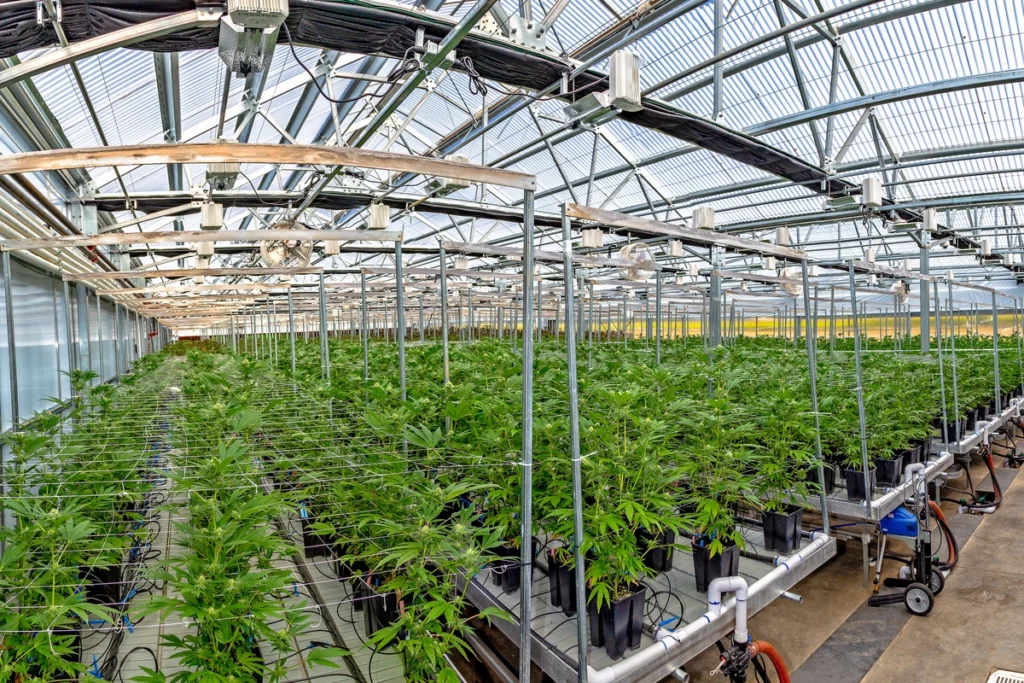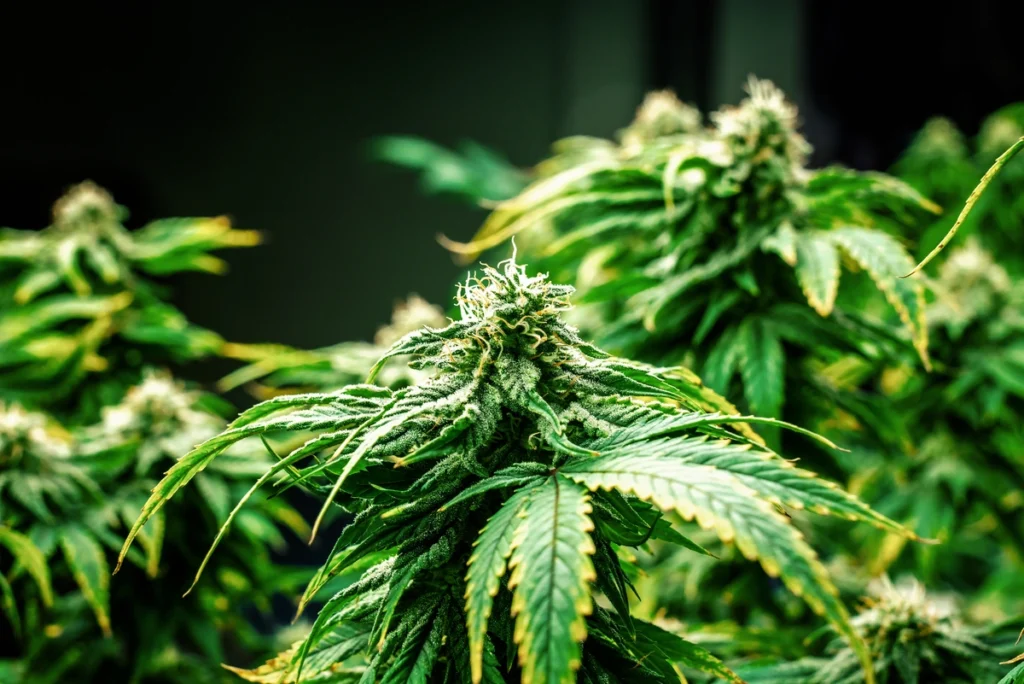With the legalization of cannabis in many regions, the market for cannabis products is booming, making indoor commercial cannabis cultivation an appealing business venture. However, growing cannabis commercially requires careful planning and precise control over various environmental factors to ensure optimal yields and product quality. This comprehensive guide will cover the essential aspects of setting up an indoor cannabis grow system for commercial production, including:
- 6 general aspects of a cannabis growing system
- Choosing the best conditions and maintaining a controlled environment
- Growing specifics
- Harvesting, drying, and curing
💡 6 General Aspects of a Cannabis Growing System

Creating a successful cannabis growing system involves understanding and integrating various essential components. From selecting the right strain and growing medium to ensuring adequate lighting and nutrient supply, each aspect plays a crucial role in promoting the health and productivity of your cannabis plants.
1. Selecting the Right Strain of Cannabis
Choosing the right cannabis strain is a crucial step in establishing a successful growing system. The ideal strain will depend on several factors, including the desired effects, growing conditions, and market demands.
Indica strains tend to have shorter flowering times and compact structures, making them suitable for indoor grow setups or smaller spaces.
Conversely, Sativa strains are known for their taller growth and longer flowering periods, which may be better suited for outdoor cultivation or larger indoor grow rooms.
Hybrids can offer a balance of both Indica and Sativa characteristics, providing versatility for different growing environments. It’s also essential to consider the strain’s resistance to pests and diseases, as well as its yield potential and cannabinoid profile. By carefully selecting a strain that aligns with your cultivation goals and environmental conditions, you can optimize plant health, productivity, and overall success.
2. Selecting the Right Growing Medium
The choice of growing medium plays a significant role in the health and yield of cannabis plants, directly impacting nutrient availability, water retention, and root support. Here are some commonly used mediums, each with its benefits and drawbacks:
- Soil:
- Traditional choice
- Offers natural nutrients and buffering capacity
- Easier for beginners to manage
- Coco Coir:
- More inert medium
- Provides excellent aeration and water retention
- Environmentally sustainable
- Hydroponic Systems:
- Use materials like rock wool or clay pellets
- Allow for precise control over nutrient delivery
- Known for rapid growth rates and high yields
The right choice will depend on factors such as the grower’s experience level, the specific strain requirements, and the desired cultivation setup. Selecting an appropriate growing medium can significantly enhance the effectiveness of your cannabis growing system, ensuring robust plant development and bountiful harvests.
3. Lighting
Lighting is one of the most crucial factors in cannabis cultivation. It affects the plant’s growth, yield, and overall health. Here’s what you need to know about lighting:
- Types of Lights: The most common types of lights used in indoor cannabis cultivation are High-Pressure Sodium (HPS) lights, Metal Halide (MH) lights, and Light Emitting Diodes (LEDs). HPS and MH lights have been industry standards for years, but LEDs are becoming increasingly popular due to their energy efficiency and long lifespan.
- Light Spectrum: Cannabis plants require different light spectrums at different growth stages. Blue light (400-500 nm) is essential during the vegetative stage for healthy leaf development, while red light (620-780 nm) is crucial during the flowering stage to promote bud formation.
- Light Intensity and Duration: During the vegetative stage, cannabis plants need 18-24 hours of light per day, while during the flowering stage, they require 12 hours of light and 12 hours of darkness to trigger bud development. The intensity of light, measured in lumens or PAR (Photosynthetically Active Radiation), should be adjusted according to the plant’s growth stage.
4. Ventilation
Proper ventilation is vital to ensure a healthy growing environment for cannabis plants. It helps regulate temperature, humidity, and CO2 levels while preventing the buildup of pests and diseases.
- Intake and Exhaust Fans: Use intake fans to bring fresh air into the grow room and exhaust fans to remove stale air. Ensure that the airflow is adequate to maintain a steady supply of CO2, which is essential for photosynthesis.
- Air Filtration: Installing carbon filters can help eliminate odors and keep the air clean. This is especially important in commercial operations to ensure compliance with local regulations regarding odor control.
5. Air Circulation
Air circulation within the grow room helps prevent mold and mildew by reducing moisture buildup and ensuring even temperature and humidity levels.
- Oscillating Fans: Place oscillating fans at different levels within the grow room to create a gentle breeze that mimics natural wind. This not only helps strengthen the plants but also ensures even distribution of CO2.
6. Temperature and Humidity
Maintaining the optimal temperature and humidity levels is crucial for the healthy growth of cannabis plants.
- Temperature: Cannabis plants thrive in temperatures between 70-85°F (20-30°C) during the day and slightly cooler temperatures at night. During the flowering stage, slightly lower temperatures (65-80°F or 18-26°C) can help enhance bud quality.
- Humidity: The ideal humidity level varies with the plant’s growth stage. During the seedling stage, maintain humidity levels around 65-70%. During the vegetative stage, reduce it to 40-70%, and during the flowering stage, lower it further to 40-50% to prevent mold and mildew.
🤔 Choosing the Best Conditions and Maintaining a Controlled Environment
Creating and maintaining the ideal environment for cannabis plants involves careful monitoring and adjustments.
Monitoring Tools
- Thermometers and Hygrometers: Use digital thermometers and hygrometers to continuously monitor the temperature and humidity levels in your grow room.
- Environmental Controllers: Automated environmental controllers can help regulate temperature, humidity, and CO2 levels, ensuring that the conditions remain within the optimal range.
Adjustments and Maintenance
- Heating and Cooling Systems: Depending on your location and the season, you may need to install heating or cooling systems to maintain the desired temperature.
- Humidifiers and Dehumidifiers: Use humidifiers to increase humidity levels and dehumidifiers to lower them as needed.
- CO2 Enrichment: Consider using CO2 generators or tanks to enrich the air with CO2, especially during the flowering stage, to boost plant growth and yield.
🌱 Growing Specifics

Germination
The germination stage is the first step in the cannabis plant’s life cycle. It involves sprouting the seeds to produce seedlings.
- Seed Selection: Choose high-quality, viable seeds from reputable suppliers. Autoflowering and feminized seeds are popular choices for commercial growers.
- Germination Methods: Common germination methods include using paper towels, starter cubes, or directly planting seeds in a growing medium. Ensure the environment is warm (70-85°F or 20-30°C) and moist, but not waterlogged.
- Light Requirements: During germination, seeds do not require intense light. Once the seedlings emerge, place them under gentle, blue-spectrum light to encourage healthy growth.
Seedling/Vegetative Stage
After germination, the plants enter the seedling stage, which gradually transitions into the vegetative stage.
- Light Schedule: Provide 18-24 hours of light per day using blue-spectrum lights. The intensity should be moderate, gradually increasing as the plants grow.
- Nutrient Requirements: Start with a mild nutrient solution specifically formulated for seedlings. As the plants grow, increase the nutrient concentration to support vigorous vegetative growth.
- Watering: Keep the growing medium consistently moist but not waterlogged. Overwatering can lead to root rot and other issues.
- Pruning and Training: During the vegetative stage, consider pruning and training techniques such as topping, fimming, and low-stress training (LST) to promote bushier growth and more bud sites.
Flowering Stage
The flowering stage is when cannabis plants develop buds, the most valuable part of the plant.
- Light Schedule: Switch to a 12/12 light schedule (12 hours of light and 12 hours of darkness) to trigger flowering. Use red-spectrum lights to enhance bud development.
- Nutrient Requirements: During the flowering stage, the plants require a different nutrient balance, with higher levels of phosphorus and potassium and lower levels of nitrogen. Use a nutrient solution specifically designed for flowering.
- Watering: Reduce the frequency of watering slightly compared to the vegetative stage. Ensure proper drainage to prevent root rot.
- Humidity and Temperature: Lower the humidity to 40-50% and maintain temperatures between 65-80°F (18-26°C) to prevent mold and mildew. Good air circulation is crucial during this stage.
- Pest and Disease Management: Regularly inspect the plants for pests and diseases. Use organic or chemical treatments as needed to protect the crop.
👉 Harvesting, Drying, and Curing
After the flowering stage, it’s time to harvest, dry, and cure the buds to ensure the highest quality product.
Harvesting
- Timing: Harvest when the trichomes (tiny resin glands on the buds) are mostly milky white with some turning amber. This indicates peak potency.
- Method: Cut the plants at the base and trim away large fan leaves. Handle the buds carefully to avoid damaging the trichomes.
Drying
- Environment: Dry the buds in a dark, well-ventilated room with temperatures between 60-70°F (15-21°C) and humidity levels around 50%.
- Method: Hang the branches upside down or use drying racks. Ensure good air circulation to prevent mold.
Curing
- Process: After drying, place the buds in airtight containers (glass jars work well) and store them in a cool, dark place.
- Burping: Open the containers daily for the first few weeks to release moisture and allow fresh air in. This process, known as “burping,” helps improve the flavor and potency of the buds.
🙌 Mastering Indoor Cannabis Cultivation: Trust APX Construction Group for Commercial Success
Setting up an indoor cannabis grow system for commercial production requires meticulous planning and attention to detail. At APX Construction Group, we understand the importance of controlling key aspects of the growing environment—such as lighting, ventilation, air circulation, temperature, and humidity—to create optimal conditions for your cannabis plants. Our team has mastered the specific stages of growing cannabis, from germination to flowering, ensuring healthy plants and high-quality yields.
By investing in the right equipment, monitoring tools, and cultivation techniques, we ensure your indoor growing systems are successful and profitable. With our dedication and continuous learning, APX Construction Group thrives in the ever-expanding cannabis industry, providing top-notch products to meet the growing demand.
Trust our expertise and commitment to excellence for your indoor cannabis grow system needs. Contact APX Construction Group today to get started on your journey to success!

